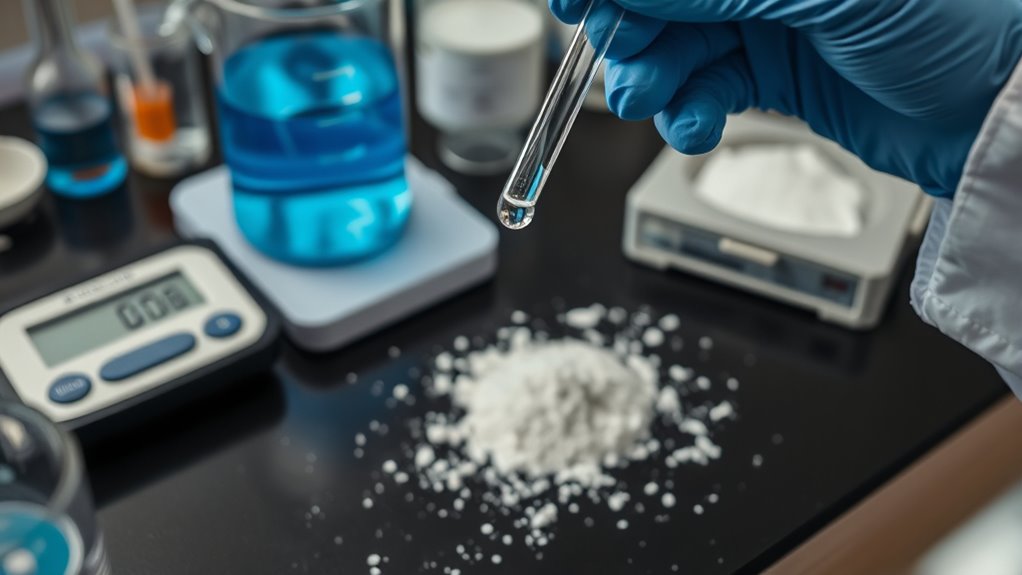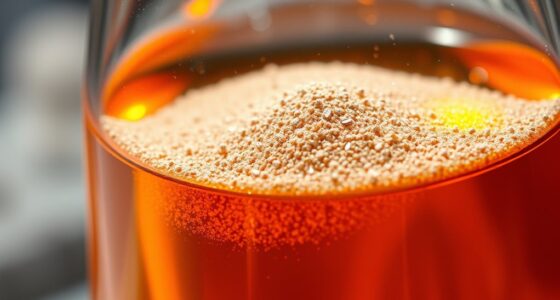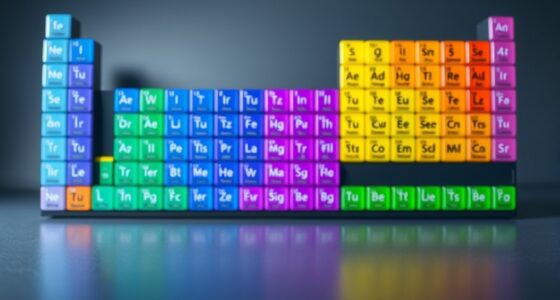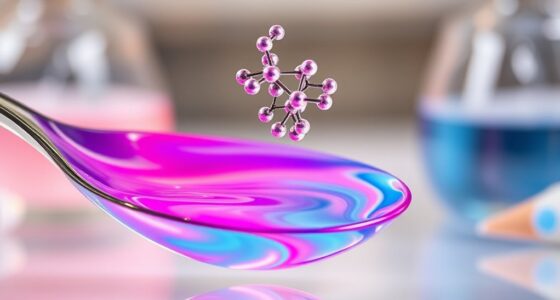To master mole-to-mole calculations quickly, start by understanding the balanced chemical equation, which gives you the mole ratios of reactants and products. Always convert all reactants to moles first before comparing them to identify the limiting reagent. Use the mole ratio as a shortcut to determine how much product each reactant can produce. Keep practicing these steps, and you’ll find it easier to solve stoichiometry problems efficiently—stick with it to unbolt more tips!
Key Takeaways
- Always convert all reactants to moles before comparing to identify the limiting reagent efficiently.
- Use the balanced chemical equation’s mole ratio to easily calculate the theoretical yield.
- Simplify calculations by focusing on the limiting reagent, ignoring excess reactants.
- Convert grams or milliliters to moles using molar mass or density to speed up the process.
- Practice memorizing common mole ratios and conversion factors to perform quick, accurate stoichiometry calculations.
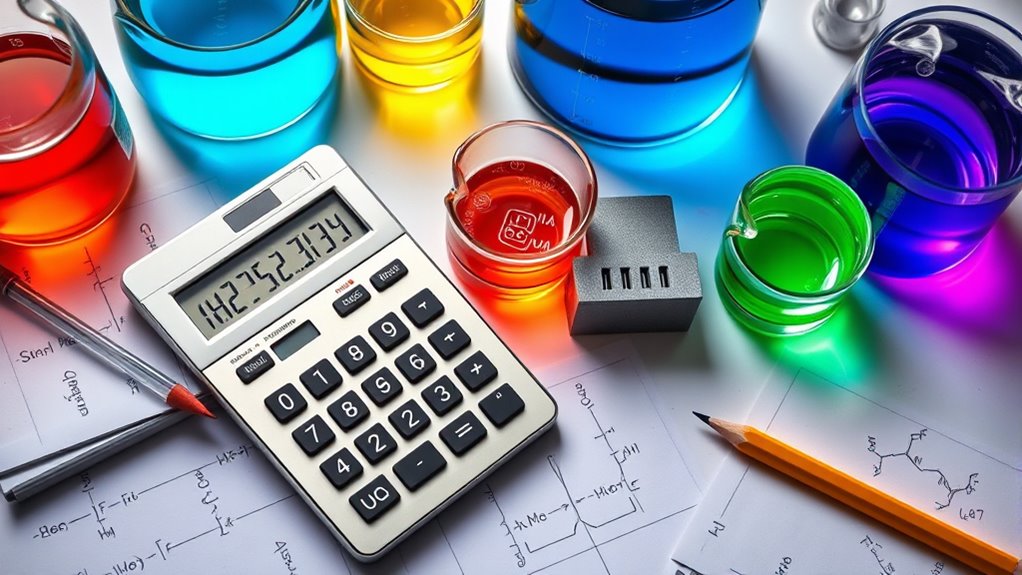
Ever wonder how to simplify complex chemical calculations? If you’re tackling stoichiometry problems, understanding the concept of the limiting reagent can make all the difference. The limiting reagent is the substance that runs out first in a reaction, determining the maximum amount of product you can produce. Recognizing it early helps you avoid unnecessary calculations and focus on what’s truly limiting your yield.
Understanding the limiting reagent simplifies stoichiometry and helps maximize product yield efficiently.
To identify the limiting reagent, you need to compare the amounts of each reactant in terms of their mole ratios to the products. Start by writing the balanced chemical equation. This provides the mole ratio between reactants and products, a vital step in solving stoichiometry problems. Additionally, understanding the reaction mechanism can give deeper insight into how reactants interact, which might influence your approach to calculations.
Once you have the balanced equation, convert your given quantities—usually in grams or milliliters—into moles. Using the mole ratio from the balanced equation, you can determine how much of each reactant can theoretically produce the desired product. Whichever reactant produces the smaller amount of product based on the mole ratio is your limiting reagent.
A common mistake is to assume the reactant in excess without checking. Instead, perform the calculations for all reactants first. For example, if you start with 10 grams of reactant A and 15 grams of reactant B, convert both to moles. Then, use the mole ratio to find out how much product each reactant can generate. The one that produces the lesser amount is your limiting reagent.
This approach saves time and reduces errors, especially in multi-step problems. Knowing the limiting reagent also streamlines your calculations for the theoretical yield. Once identified, you can focus on the limiting reagent to determine the maximum amount of product possible.
This is the key to mastering mole-to-mole calculations quickly. Remember, the mole ratio acts as a conversion factor; it links the amount of reactants to the amount of products. By practicing this process—converting to moles, applying the mole ratio, and pinpointing the limiting reagent—you’ll gain confidence and speed in solving stoichiometry problems.
In essence, mastering the interplay between the limiting reagent and mole ratio transforms a formidable calculation into a straightforward process. With consistent practice, you’ll instinctively identify the limiting reagent and apply the correct mole ratios, making your stoichiometry hacks more effective and efficient.
Additionally, understanding how Bedroom decor can influence your mood and productivity can help create a more conducive environment for studying chemistry, making your learning process even more effective.
Frequently Asked Questions
How Do I Convert Moles to Particles or Atoms?
To convert moles to particles or atoms, start with your given moles and use Avogadro’s number, which is 6.022 x 10²³. Multiply the number of moles by Avogadro’s number to find the total particles.
If you know the molecular formula, you can determine the number of atoms per molecule and then multiply accordingly. This method helps you move seamlessly from moles to individual particles or atoms.
What Are Common Mistakes in Mole-To-Mole Conversions?
Think of mole-to-mole conversions like following a recipe; accuracy matters. Common mistakes include forgetting to use the correct reaction coefficients in your unit conversion, which can throw off your calculations.
Double-check that you’re aligning the coefficients properly and canceling units correctly. Avoid rushing through steps, and always revisit your work to verify the ratios match the balanced chemical equation.
Precision ensures your reaction calculations are spot-on.
How Can I Quickly Identify Limiting Reactants?
To quickly identify limiting reactants, compare the mole ratio of your reactants to the balanced chemical equation.
Focus on the reactant that produces the least amount of product, considering the reaction yield.
Remember, excess reagent remains after the reaction, so it’s not limiting.
Are There Tools to Automate Stoichiometry Calculations?
Think of reaction automation like having a personal assistant for your chemistry work. You can use software tools to do complex stoichiometry calculations quickly and accurately, saving you time and reducing errors.
I once used a program that instantly balanced reactions and identified limiting reactants, proving how these tools streamline the process. Yes, many software options are available to automate stoichiometry calculations, making your chemistry tasks more efficient and less stressful.
How Does Balancing Equations Affect Mole Calculations?
Balancing equations directly impacts mole calculations because reaction coefficients reflect the ratio of reactants and products. When you balance an equation, you guarantee the conservation of mass, which means the number of atoms remains consistent.
This allows you to accurately convert moles of one substance to another, using the coefficients as conversion factors. Proper balancing ensures your mole calculations align with the true proportions in the chemical reaction.
Conclusion
Now that you’ve unlocked these stoichiometry hacks, you’re practically a mole-mastery magician! No more sweating over calculations or feeling lost in the chemical chaos. With these tricks, you’ll breeze through mole-to-mole conversions faster than lightning strikes, turning complex problems into child’s play. Get ready to conquer chemistry with unstoppable confidence—because once you master these hacks, you’ll rule the lab like a true molecular maestro! The periodic table doesn’t stand a chance against your newfound skills!
